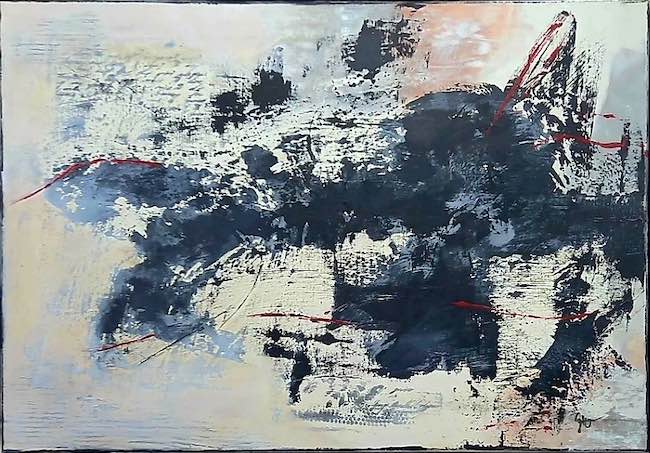Il mondo delle sensazioni si manifesta in maniera diversificata sulla base della sensibilità e della natura del singolo artista, poiché di fatto la scelta di lasciarsi dominare da quella dimensione interiore che necessita di conseguenza un linguaggio libero dalla forma e per questo completamente istintivo, diviene un’estensione del sé al punto di poter essere identificato con il carattere dell’autore di un’opera. Vi sono però alcuni creativi che hanno una personalità più sfaccettata e mutevole e dunque necessitano di lasciar emerge i diversi aspetti che di volta in volta devono svelarsi sulla base della sensazione narrata o dell’istante percettivo in cui si pongono davanti alla tela. La protagonista di oggi rappresenta in pieno questa categoria di artisti e mostra nella sua produzione artistica quella costante alternanza tra impulso e meditazione emotiva che fa parte della sua natura.
I primi decenni del Novecento furono un concitato periodo dal punto di vista artistico poiché videro la nascita di molti movimenti il cui scopo principale era distaccarsi dalle regole precedenti, considerate troppo tradizionali e poco al passo con i tempi moderni, e trovare nuovi linguaggi espressivi attraverso i quali rompere gli schemi precedenti e mostrare l’autonomia dell’espressione creativa da un legame con la realtà osservata in passato irrinunciabile. Molti tra questi movimenti artistici si distaccarono completamente da tutto ciò che l’occhio poteva cogliere nell’ambiente circostante, dando vita a un tipo di linguaggio che non doveva avere riferimenti formali ed estetici con l’osservato e non poteva neanche essere espressione della soggettività dell’autore; i protagonisti del De Stijl, del Suprematismo e dell’Astrattismo Geometrico erano impegnati ad affermare con forza la supremazia del gesto plastico, dell’atto pittorico, su qualsiasi intrusione emozionale, lasciando dunque all’analisi razionale il compito di rappresentare le linee guida su cui quegli stili si fondavano. Già a partire dalla metà dagli anni Trenta del Novecento, in particolar modo negli Stati Uniti, si delineò l’esigenza di reinterpretare le avanguardie dei decenni precedenti, compresa quell’Arte Astratta che in Europa sembrava mancante di un elemento essenziale, l’emozione; con la fine della seconda guerra mondiale un gruppo di artisti, molti dei quali migrati in America per sfuggire alle persecuzioni naziste, si riunì per dare vita a un movimento dove l’approccio informale reintroducesse tutto quel mondo emozionale che aveva bisogno di divenire protagonista del gesto pittorico. Quel movimento prese il nome di Espressionismo Astratto e introdusse il concetto innovativo dell’azione che entrava di diritto all’interno dell’opera; l’Action Painting era un gesto istintivo, non guidato dalla razionalità, non necessitante l’analisi scientifica sull’equilibrio delle forme né tanto meno del disegno preparatorio o della regolarità geometrica. Nell’Espressionismo Astratto tutto era lasciato alla libertà istintiva della creazione e soprattutto all’impulso pittorico naturale di ciascun interprete, ecco perché anche il Color Field di Mark Rothko e di Helen Frankenthaler, la pittura segnica di Hans Hartung e di Cy Twombly, la leggera figurazione di Philip Guston e di Alfred L. Copley potevano convivere sotto lo stesso gruppo artistico; ciò che doveva emergere era l’emozione, quel mondo ingestibile dalla razionalità che fuoriusciva senza limiti e senza regole, propagandosi dall’autore alla tela e poi dalla tela all’osservatore che ne rimaneva inevitabilmente coinvolto. L’artista austriaca Gabriele Uher sceglie a sua volta l’Espressionismo Astratto per raccontare le sue riflessioni, il suo mondo interiore, attraverso un linguaggio pittorico personale che si ispira all’arte segnica di Cy Twombly unita al Color Field di Clyffor Still, spostandosi più verso l’uno o verso l’altro sulla base di quale dei due lati della sua natura emerge in maniera più preponderante nel momento in cui lei si siede davanti alla tela e dà inizio al processo creativo.
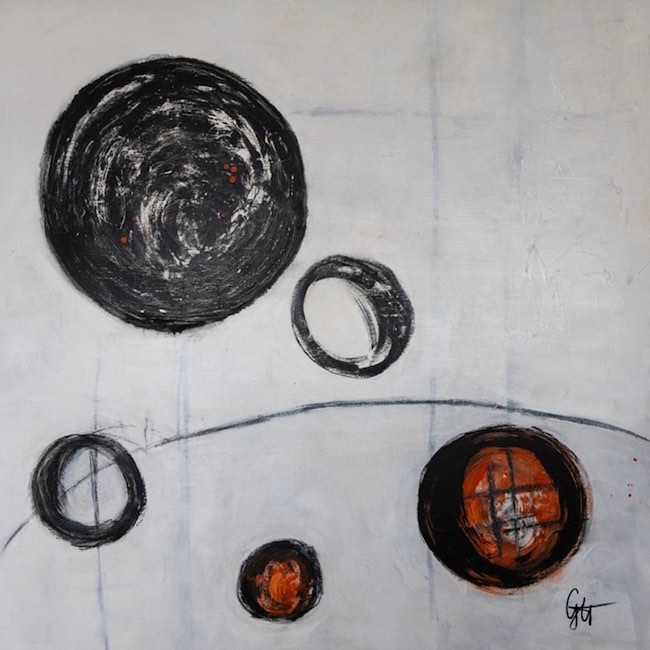
In alcune opere affiora infatti in maniera evidente un’attitudine lirica, una suggestione cromatica basata sulla scala di grigi e di un apporto segnico delicato, quasi trasparente per suggerire la necessità di soffermarsi sul concetto espresso e trovare la propria risposta ai sussurrati suggerimenti di Gabriele Uher; in altri dipinti a fuoriuscire è il lato più impulsivo e travolgente quello che si traduce in un’action painting veloce, rapida, quasi fosse necessaria a non perder la sensazione di quel preciso frangente.
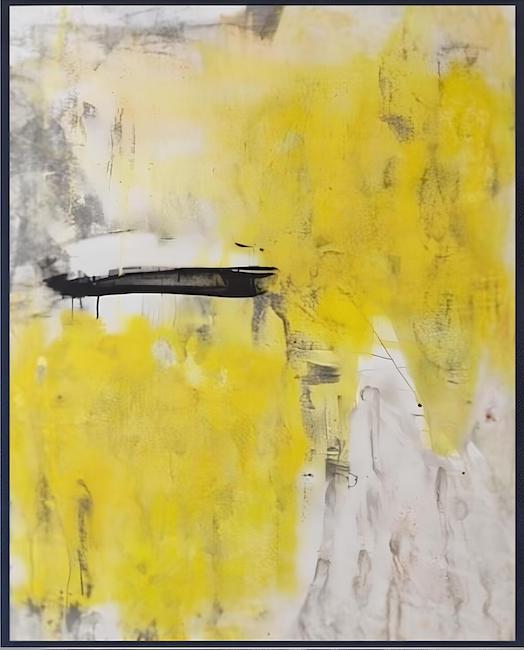
In questa seconda serie di opere le tonalità sono più vivaci, le macchie di colore si mescolano ai segni grafici, che contraddistinguono la produzione dell’artista, per generare un messaggio più intenso, più vibrante proprio perché traduzione di sensazioni che per natura non possono essere oggetto di una riflessione, di un argine che ne limiterebbe la spontaneità; oppure raccontano il punto di vista di Gabriele Uher su fenomeni naturali e pianeti che stimolano e arricchiscono il corso della vita o che ne determinano le dinamiche e così, anche in queste tele, l’impulso è quello di tradurne l’effetto emozionale che generano in lei in particolare e nell’essere umano in generale.
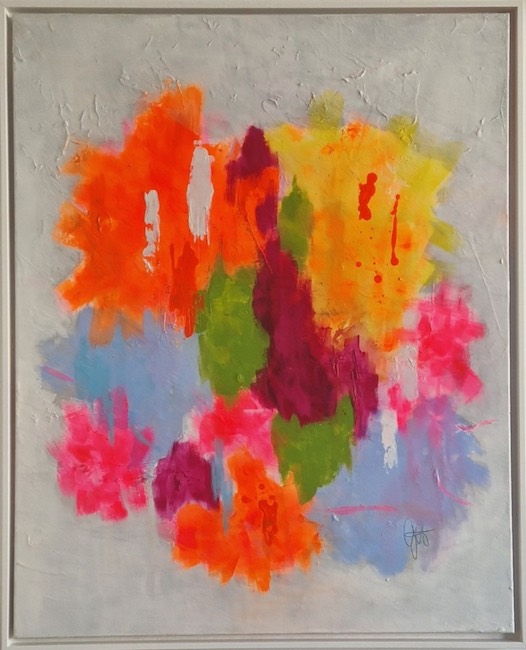
Il dipinto Springtime appartiene a quest’ultimo insieme di opere, e mostra tutta l’allegria e la serenità generati dalla stagione della rinascita, quella durante la quale la natura esce dal lungo sonno invernale e rivela tutti i suoi colori più belli; la scelta cromatica dei campi di colore è calda, vivace, vicina a quella dei fiori che in quella stagione si dischiudono con tutta la loro bellezza propagando la medesima sensazione anche sull’individuo che si lascia trascinare dalla gioia del riscoprire il sole e il cielo azzurro. Gabriele Uher coinvolge l’osservatore proprio attraverso la medesima spontaneità con cui la natura sboccia generando un’atmosfera più aperta e piacevole rispetto al freddo dei mesi precedenti, e il calore delle tonalità scelte avvolge proprio in virtù di un’energia cromatica che fuoriesce dalla tela.
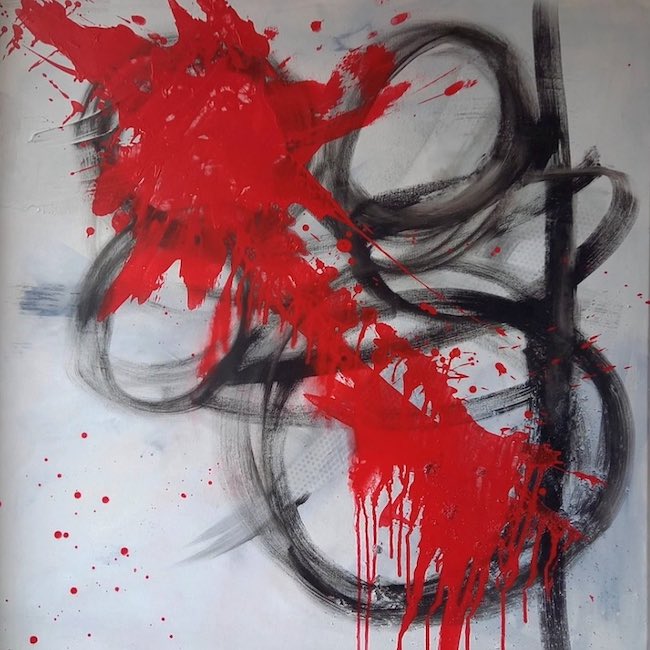
In Emotionen invece scende più in profondità, il suo sguardo diventa più intimista e si perde dentro quelle sensazioni che non possono fare a meno di erompere senza controllo da parte della mente, come d’altronde accade appunto con le emozioni che sono ingestibili da qualsiasi limite razionale, si ribellano e gridano a gran voce i loro segreti. Questo è ciò che emerge dal dipinto dove sullo sfondo neutro e sulla parte segnica costituita dal nero irrompe il passionale rosso, che lanciato attraverso il dripping rompe ogni equilibrio e si mostra con tutta la sua travolgente intensità; la comunicatività impulsiva diviene dunque essenziale nello stile pittorico della Uher dove ogni segno, ogni colore ha un suo ruolo specifico sebbene poi l’esecuzione plastica sia completamente lasciata all’impulso creativo dell’istante presente.

Poi però anche il suo lato più meditativo ha bisogno di emergere, come se la sua personalità avesse bisogno di conciliare gli opposti per sentirsi perfettamente bilanciata e in armonia con se stessa, lasciando all’osservatore l’invito implicito a conoscersi, ad accettare tutte le sue sfaccettature per vivere una vita più piena. A questa seconda filosofia espressiva appartengono le opere che esplorano temi più esistenziali, quelli legati alle domande irrisolte della vita e su quale sia l’approccio migliore per viverla e Gabriele Uher prova a dare la sua versione, la sua personale interpretazione senza imporla bensì stimolando all’introspezione per trovare ciascuno la propria risposta, più affine alla propria natura e alla propria esperienza.
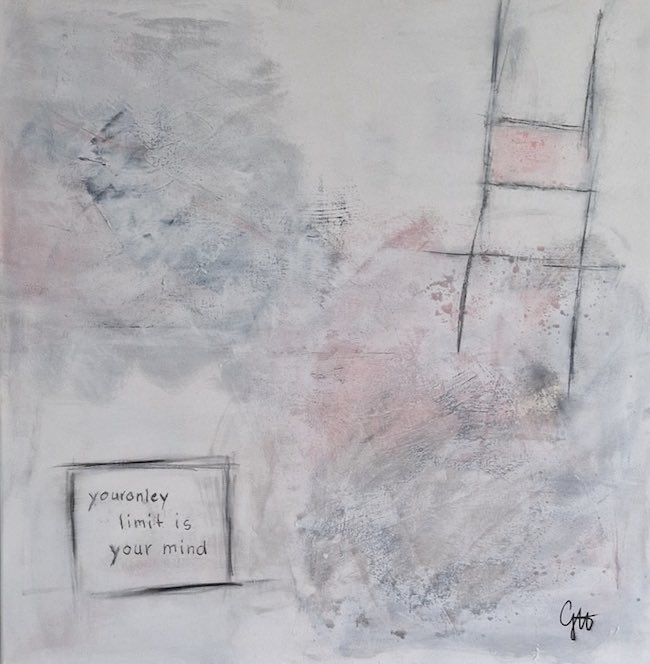
Qui la gamma cromatica si riduce, si sintonizza sulla scala di grigi per mettere in risalto una necessità di raccoglimento, di approfondimento meditativo sulle tematiche di volta in volta affrontate; il segno grafico si sfuma ma diviene essenziale, indispensabile per enfatizzare il concetto, come nella tela No limit dove le sfumature in rosa molto chiaro sembrano essere l’eco di una consapevolezza perduta ma da recuperare, quella incisa come un manifesto pubblicitario sul rettangolo grafico in basso in cui Gabriele Uher scrive la frase che diviene esortazione a prendere consapevolezza della propria forza interiore.
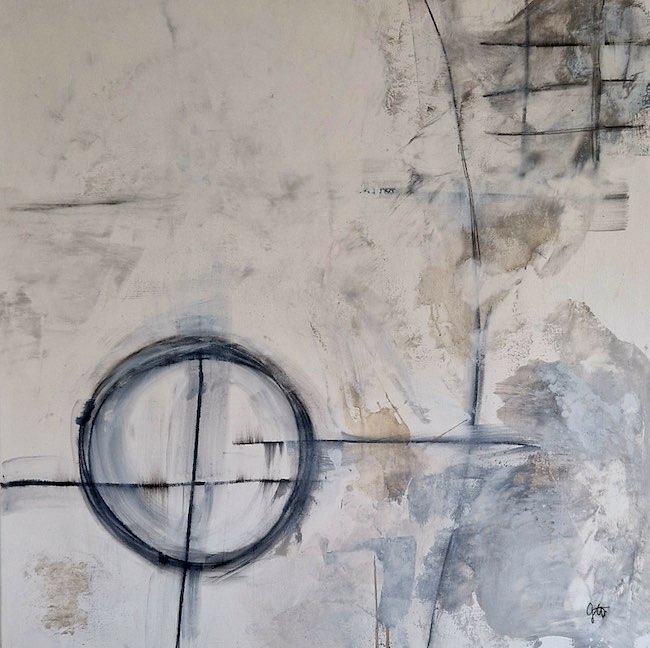
O in Everything is possible in cui il cerchio quasi dissolto o cancellato assume il significato di resilienza, di resistenza agli accadimenti da cui, se affrontati positivamente, si può cogliere un insegnamento prezioso e trovare una via d’uscita insperata e diversa da quanto ipotizzato in un primo momento. Gabriele Uher si è formata alla Scuola d’Arte di Vienna ed è membro del gruppo di artisti IMALA e dell’Associazione professionale degli artisti visivi austriaci e ha al suo attivo mostre collettive e personali in Austria e Germania. Le sue opere appartengono a collezioni private in Germania e Austria, e alcune sono state acquisite dal Comune di Gutenstetten in Germania.
GABRIELE UHER-CONTATTI
Email: g.uher@hotmail.com
Sito web: www.gabriele-uher.at/
Facebook: www.facebook.com/gabriele.uher.54
Instagram: www.instagram.com/gabrieleuher/
The alternation between instinct and emotion in the Abstract Expressionism of Gabriele Uher’s artworks
The world of sensations manifests itself in different ways based on the sensitivity and nature of the individual artist, since in fact the choice to let oneself be dominated by that inner dimension that consequently requires a language free of form and therefore completely instinctive, becomes an extension of the self to the point of being able to be identified with the character of the author of an artwork. There are, however, some creatives who have a more multifaceted and changeable personality and therefore need to let emerge the different aspects, which from time to time have to reveal themselves on the basis of the narrated sensation or the perceptive instant in which they place themselves in front of the canvas. Today’s protagonist fully represents this category of artists and shows in her artistic production that constant alternation between impulse and emotional meditation that is part of her nature.
The first decades of the 20th century were a turbulent period from an artistic point of view as they saw the birth of many movements whose main aim was to break away from the previous rules, considered too traditional and out of step with modern times, and find new expressive languages through which to break previous patterns and show the autonomy of creative expression from a previously inalienable link with observed reality. Many of these artistic movements completely detached themselves from everything the eye could grasp in the surrounding environment, giving rise to a type of language that had no formal and aesthetic references to the observed and could not even be an expression of the author’s subjectivity; the protagonists of De Stijl, Suprematism and Geometric Abstractionism were committed to forcefully asserting the supremacy of the plastic gesture, of the pictorial act, over any emotional intrusion, thus leaving rational analysis the task of representing the guidelines on which those styles were based. As early as the mid-1930s, particularly in the United States, emerged the need to reinterpret the avant-gardes of previous decades, including that Abstract Art that in Europe seemed to lack an essential element, emotion; with the end of the Second World War, a group of artists, many of whom had migrated to America to escape Nazi persecution, came together to give life to a movement where the informal approach reintroduced the whole emotional world that needed to become the protagonist of the pictorial gesture.
That movement took the name of Abstract Expressionism and introduced the innovative concept of the action that entered by right into the work; Action Painting was an instinctive gesture, not guided by rationality, not requiring scientific analysis of the balance of forms, nor of preparatory drawing or geometric regularity. In Abstract Expressionism, everything was left to the instinctive freedom of creation and above all to the natural pictorial impulse of each interpreter, which is why even the Colour Field of Mark Rothko and Helen Frankenthaler, the sign painting of Hans Hartung and Cy Twombly, the light figuration of Philip Guston and Alfred L. Copley could coexist under the same artistic group; what had to emerge was emotion, that world unmanageable by rationality that escaped without limits and without rules, propagating from the author to the canvas and then from the canvas to the observer who inevitably became involved. The Austrian artist Gabriele Uher in turn chooses Abstract Expressionism to narrate her reflections, her inner world, through a personal pictorial language that is inspired by the sign art of Cy Twombly combined with the Colour Field of Clyffor Still, moving more towards one or the other on the basis of which of the two sides of her nature emerges more predominantly when she sits in front of the canvas and begins the creative process. Indeed, in some works, emerges clearly a lyrical attitude, a chromatic suggestion based on the grey scale and a delicate, almost transparent sign contribution to suggest the need to dwell on the concept expressed and find one’s own response to Gabriele Uher‘s whispered suggestions; in other paintings, it is the more impulsive and overwhelming side that emerges, the one that translates into fast, rapid action painting, as if it were necessary in order not to lose the feeling of that precise moment. In this second series of paintings, the tones are more vivid, the patches of colour mingle with the graphic signs that distinguish the artist’s production, to generate a more intense message, more vibrant precisely because they are the translation of sensations that by nature cannot be the object of reflection, of a curb that would limit their spontaneity; or tell Gabriele Uher‘s point of view on natural phenomena and planets that stimulate and enrich the course of life or determine its dynamics and so, in these canvases too, the impulse is to translate the emotional effect they generate in her in particular and in human beings in general. The painting Springtime belongs to this last set of works, and shows all the joy and serenity generated by the season of rebirth, the one during which nature comes out of its long winter sleep and reveals all its most beautiful colours; the choice of the colour fields is warm, lively, close to that of the flowers that in that season open with all their beauty, propagating the same sensation on the individual who lets himself be carried away by the joy of rediscovering the sun and the blue sky. Gabriele Uher involves the observer precisely through the same spontaneity with which nature blossoms, generating a more open and pleasant atmosphere compared to the cold of the previous months, and the warmth of the chosen tones envelops precisely by virtue of a chromatic energy that escapes from the canvas. In Emotionen, on the other hand, she descends deeper, her gaze becomes more intimist and she loses herself in those sensations that cannot help but erupt without control by the mind, as indeed happens with emotions that are unmanageable by any rational limitation, they rebel and cry out their secrets.
This is what emerges from the painting where, on the neutral background and on the sign-like part made up of black, the passionate red bursts in, which, thrown through dripping, breaks every balance and shows itself with all its overwhelming intensity; impulsive communicativeness thus becomes essential in Uher‘s pictorial style where every sign, every colour has its own specific role although the plastic execution is then completely left to the creative impulse of the present instant. But then also needs to emerge her more meditative side, as if her personality needed to reconcile opposites in order to feel perfectly balanced and in harmony with itself, leaving the observer with an implicit invitation to get to know herself, to accept all his facets in order to live a fuller life. To this second expressive philosophy belong the works that explore more existential themes, those linked to the unresolved questions of life and what is the best approach to living it, and Gabriele Uher tries to give her version, her personal interpretation without imposing it but rather stimulating introspection in order to find each one’s own answer, more akin to one’s own nature and experience.
Here the chromatic range is reduced, tuned to the grey scale to emphasise a need for meditation, for meditative investigation of the themes tackled from time to time; the graphic sign fades but becomes essential, indispensable for emphasising the concept, as in the canvas No limit where the shades in very light pink seem to be the echo of an awareness lost but to be recovered, the one engraved like an advertising poster on the graphic rectangle at the bottom in which Gabriele Uher writes the phrase that becomes an exhortation to become aware of one’s own inner strength. Or in Everything is possible in which the almost dissolved or erased circle takes on the meaning of resilience, of resistance to events from which, if faced positively, one can learn a valuable lesson and find a way out that is unhoped for and different from what was initially hypothesised. Gabriele Uher trained at the Vienna School of Art and is a member of the IMALA group of artists and the Professional Association of Austrian Visual Artists. She has group and solo exhibitions in Austria and Germany to her credit. Her artworks belong to private collections in Germany and Austria, and some have been acquired by the Municipality of Gutenstetten in Germany.


